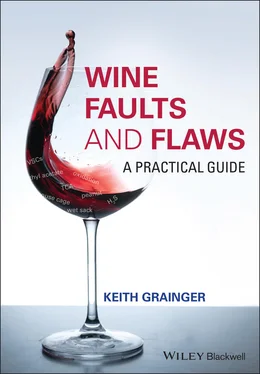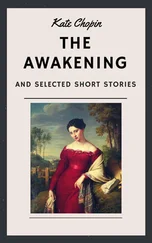Keith Grainger - Wine Faults and Flaws
Здесь есть возможность читать онлайн «Keith Grainger - Wine Faults and Flaws» — ознакомительный отрывок электронной книги совершенно бесплатно, а после прочтения отрывка купить полную версию. В некоторых случаях можно слушать аудио, скачать через торрент в формате fb2 и присутствует краткое содержание. Жанр: unrecognised, на английском языке. Описание произведения, (предисловие) а так же отзывы посетителей доступны на портале библиотеки ЛибКат.
- Название:Wine Faults and Flaws
- Автор:
- Жанр:
- Год:неизвестен
- ISBN:нет данных
- Рейтинг книги:4 / 5. Голосов: 1
-
Избранное:Добавить в избранное
- Отзывы:
-
Ваша оценка:
- 80
- 1
- 2
- 3
- 4
- 5
Wine Faults and Flaws: краткое содержание, описание и аннотация
Предлагаем к чтению аннотацию, описание, краткое содержание или предисловие (зависит от того, что написал сам автор книги «Wine Faults and Flaws»). Если вы не нашли необходимую информацию о книге — напишите в комментариях, мы постараемся отыскать её.
FLAWS
Wine Faults and Flaws: A Practical Guide
An essential guide to the faults and flaws that can affect wine
Wine Faults and Flaws — читать онлайн ознакомительный отрывок
Ниже представлен текст книги, разбитый по страницам. Система сохранения места последней прочитанной страницы, позволяет с удобством читать онлайн бесплатно книгу «Wine Faults and Flaws», без необходимости каждый раз заново искать на чём Вы остановились. Поставьте закладку, и сможете в любой момент перейти на страницу, на которой закончили чтение.
Интервал:
Закладка:
2.6.3.3 Tertiary Aromas
Tertiary aromas result from the maturation and ageing process of the wine, particularly in bottle. During this time, there will be many chemical reactions. Following fermentation the wine will already contain some dissolved oxygen (DO), and for wines that are barrel‐matured, more oxygen will be absorbed through the cask. Provided the barrels are kept topped‐up, there will only be a small amount of beneficial oxygenation taking place, which will increase the aldehyde content of the wine. Wines matured in new barrels will absorb the greatest amount of oxygen, together with oak compounds including vanillin, lignin, and tannin. Those matured in second and third fill barrels will also pick up these, but to a lesser extent, for the pores in the wood become blocked with repeated use. Wines that are not matured in barrels may be micro‐oxygenated, and ‘oaked’ in other ways, including chips, beans, and powder.
Wine maturation in bottle results in continuous changes to the volatile compounds of the wine. At bottling time, there will be some DO in the wine, and typically some in the headspace of the bottle. This oxygen present at bottling is rapidly consumed by the wine [9]. During ageing and storage more may be absorbed from the closure itself (particularly if this is cork), through the closure depending upon type, and the interface between the closure and bottle. However, many of the changes that take place during bottle maturation are reductive. These changes take place as the oxygen content of the wine is gradually reduced. It is this process that makes bottle ageing a necessity for the maturation of many fine wines, especially full‐bodied reds. A wine that is not able to be reduced is a dead wine. However, reduced aromas are usually regarded as a fault, and this topic will be discussed in Chapter 6. As fine wines mature the tertiary aromas develop, and these can exhibit a complex array of seamless, interwoven characteristics, at best all in total harmony. Tertiary aromas are those that often evoke the most descriptive comments. Examples that might be found on red wines include shoe‐leather, Havana cigar, woodland floor, truffle, autumnal gardens, game – the list is almost endless. Tertiary aromas on white wines might include hay, honey, nuts, nutmeg, and kerosene (this might be regarded as a fault, as discussed in Chapter 15). Many vegetal characteristics that may be present in wines of any colour also belong to the tertiary group. Some of these, if present in excess, may be distinctly unpleasant.
When wines are aged beyond their projected lifespan, or suffer premature decline (perhaps due to poor storage), all of the primary and many of the secondary aromas will be lost. Of the tertiary aromas that remain, some such as caramel, toffee or soaked fruitcake may be pleasant, but many will not. The smell of rotting cabbage, stale sweat, old trainers and burnt saucepans may come to the fore, and every hint of complexity will have been drained out, rendering the wine flawed.
The descriptors for the development of the nose may range from youthful to fully developed . When desirable aromatic compounds are waning and unwelcome characteristics of a tertiary nature, e.g. rotting vegetables, are assertive, the wine may be described as tired .
Some wines go from youthful to tired without ever passing through the fully developed stage. Examples include much Beaujolais and inexpensive Valpolicella. However, there are also types of wine that are bottled fully developed, such as Sherry, Tawny Port and some sparkling wines.
2.6.3.4 Aroma Characteristics
Some older tasters, and wine writers, distinguish between the terms ‘aroma’ and ‘bouquet’. They use the term ‘aroma’ when referring to the primary aromas derived from the grapes. ‘Bouquet’ would encompass the assembled characteristics resulting from changes that have taken place during fermentation (secondary aromas), and particularly maturation and ageing (tertiary aromas). The distinction is far from clear‐cut, and as such, the words ‘aroma’ and ‘odour’ are used in this book as all‐encompassing terms.
There are some 800 or more volatile compounds that have been identified in wines, in concentrations ranging from a few nanogrammes to hundreds of milligrammes per litre. The olfactory perception thresholds of odorous compounds vary from 4 pg/l, to 100 mg/l, but the sensory threshold for any individual compound may differ when present with other compounds. It is even possible that some compounds may be detected at concentrations of a few femtogrammes per litre (fg/l).
There has been considerable research over the last couple of decades into the identification of the individual compounds (and their precursors) that contribute to wine aromas. These activities are still in their infancy. Table 2.3lists some of the compounds contributing to individual aromas, including their origins and typical odour detection thresholds. The Sauvignon Blanc variety has been particularly well studied in respect of the precursors, development, and reactions of volatile thiols in the grapes, must, and wine, as reviewed in 2012 by Coetzee and du Toit [10]. The aromas commonly found in a young wine made from Sauvignon Blanc, and the volatile thiols that responsible for these aromas, are shown in Table 2.4.
Table 2.3 Some compounds responsible for wine aromas, their origins, aroma descriptors, and typical sensory detection thresholds.
| Compound | Aroma descriptors | Sensory detection threshold a) |
|---|---|---|
| Primary aromas | ||
| Terpenes | ||
| Wine lactone | Lime, coconut, wood, sweat | 10 ng/l |
| Linalool | Floral, rose, lavender ‘Muscat’ grape | 25 μg/l |
| Geraniol | Geranium, rose, citronella | 30–130 μg/l |
| Nerol | Rose | 200–300 μg/l |
| α‐Terpineol | Lily of the Valley, spice | 250–400 μg/l |
| Citonellol | Citronella | 18–100 μg/l |
| Cis‐ Rose oxide | Lychee, rose | 100–200 ng/l |
| Trans‐ rose oxide | Rose | 80 μg/l |
| 1,8‐Cineole (eucalyptol) | Eucalyptus | 3.2 μg/l |
| N.B. Over 50 terpenes have been identified in grapes | ||
| Secondary (fermentation) aromas | ||
| Esters | ||
| Ethyl acetate | Pear drops, solvent, nail varnish remover (levels above 100 mg/l may regarded as a fault) | 3.6–13 mg/l |
| Ethyl propanoate | Cherry | 2.1 mg/l |
| Ethyl‐2‐Methylpropanoate | Strawberry, banana | 1.8 mg/l |
| Ethyl hexanoate | Green apple, aniseed | 14–140 μg/l |
| Ethyl octanoate | Meat fat | 5 μg/l |
| Ethyl Decanoate | Floral, grape | 200 μg/l – 1.5 mg/l |
| Ethyl butanoate (ethyl butyrate) | Pineapple | 20–400 μg/l |
| Ethyl isovalerate | Fruits | 3 μg/l |
| Isoamyl acetate | Banana | 30 μg/l – 2.7 mg/l |
| Hexyl acetate | Pear | 2.4 mg/l |
| Phenylethyl acetate | Rose, honey | 250 μg/l – 6 mg/l |
| 2‐Phenylethanol | Floral | 20 mg/l |
| Alcohols | ||
| Ethanol | Alcohol! | 100 mg/l |
| 2‐Phenylethyl alcohol | Rose, lilac | 14 mg/l |
| Isoamyl alcohol | Malted barley, Whisky | 30 mg/l |
| 1‐Hexanol | Cut grass | 4.5 μg/l |
| Wood (maturation) aromas | ||
| 2‐Furfurylthiol | Roasted coffee | 4 pg/l |
| Furfural | Almond | 20 mg/l |
| Eugenol | Clove, spice | 500 μg/l |
| Trans ‐Nonenal | Sawn wood | 250 ng/l |
| cis/trans ‐Whiskylactone | Coconut | 125 μg/l |
| Guaicol | Smoke | 75 μg/l |
| Vanillin | Vanilla | 200–320 μg/l |
| Maltol | Caramel | 30 μg/l |
a)Sensory detection thresholds depend upon many criteria, including the presence of other compounds and the wine matrix. The figures stated have been extrapolated from numerous sources.
Читать дальшеИнтервал:
Закладка:
Похожие книги на «Wine Faults and Flaws»
Представляем Вашему вниманию похожие книги на «Wine Faults and Flaws» списком для выбора. Мы отобрали схожую по названию и смыслу литературу в надежде предоставить читателям больше вариантов отыскать новые, интересные, ещё непрочитанные произведения.
Обсуждение, отзывы о книге «Wine Faults and Flaws» и просто собственные мнения читателей. Оставьте ваши комментарии, напишите, что Вы думаете о произведении, его смысле или главных героях. Укажите что конкретно понравилось, а что нет, и почему Вы так считаете.












